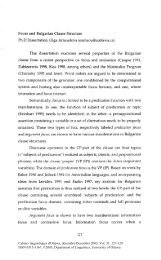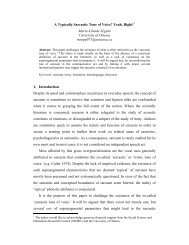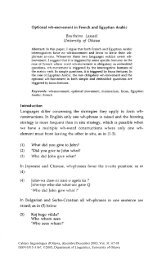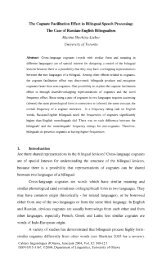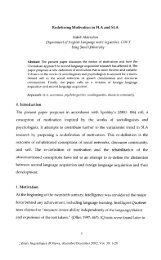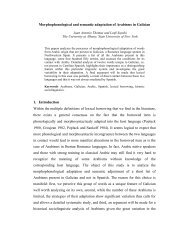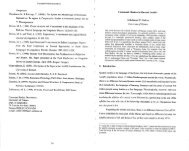Interlingual and Intralingual Interference during Gender Production
Interlingual and Intralingual Interference during Gender Production
Interlingual and Intralingual Interference during Gender Production
Create successful ePaper yourself
Turn your PDF publications into a flip-book with our unique Google optimized e-Paper software.
Denisa Bordag<br />
them their corresponding gender nodes, which they automatically activate.<br />
Selection of the second language lemma should thus be delayed <strong>and</strong> subjects<br />
should produce more gender errors compared to the condition where both<br />
translation equivalents have congruent genders. We will use the term gender<br />
interference effect to refer to the negative effect of the first language gender on<br />
the selection of the gender of its second language translation equivalent.<br />
Conceptualization<br />
<br />
Grammatical<br />
encoding<br />
(lemmas)<br />
I<br />
I<br />
I<br />
I<br />
, I Phonological<br />
<br />
encoding<br />
(phonological forms)<br />
[hrad]<br />
Articulation<br />
Figure I: <strong>Gender</strong> interference effect: The gender node of the target second language word "hrad"<br />
(castle, masculine in Czech) competes for selection with the gender node of its automatically<br />
activated first language translation equivalent "burg" (feminine in German).<br />
2.1 Experiments<br />
Two experiments were constructed to explore whether such a gender interference<br />
effect indeed exists. Two languages, German <strong>and</strong> Czech, were chosen to be<br />
employed in these experiments. Both these languages have grammatical gender<br />
<strong>and</strong> the number <strong>and</strong> type of their genders is identical: masculine, feminine <strong>and</strong><br />
6



